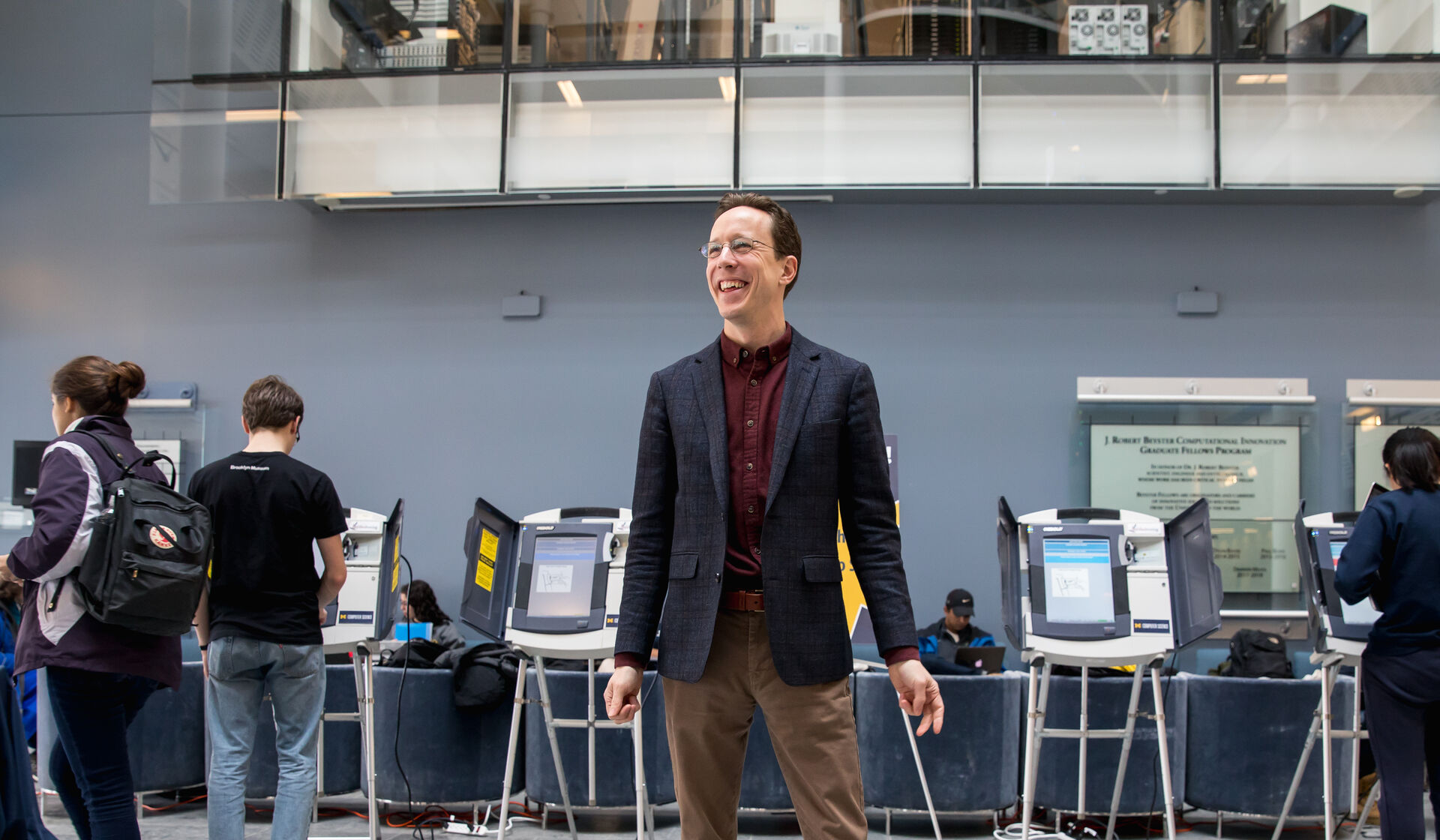Last fall, U-M alumna Mona Hanna-Attisha revealed the elevated levels of lead in Flint’s children. But her journey to discovering the contaminated water began as a child, when she first learned about social justice issues from her own family.
It wasn’t until an impromptu dinner party last summer that Mona Hanna-Attisha had reason to warn her patients away from the water in Flint. A pediatrician in the city, she had heard concerns from families when Flint started drawing its water from the Flint River. However, public health officials insisted the water was fine.
But things changed when she hosted an old friend from high shool — water expert Elin Betanzo — who fatefully suggested that Hanna-Attisha, ’98, MPH’08, look at children’s blood-lead levels in Flint. That conversation led to a crucial study that exposed to the world what is now well known: The water in Flint was toxic, poisoning as many as 27,000 children and their parents with lead levels high enough to cause serious medical, mental, and cognitive impairments.
Until then, tests of the Flint water had produced some results that were worrisome but not conclusive enough to grab the world’s attention. Hanna-Attisha, director of the Pediatric Residency Program at Flint’s Hurley Medical Center and a Michigan State University medical school professor, was the first to document that the number of Flint children with elevated blood-lead levels had nearly doubled since Flint started drawing its water from the river. In some neighborhoods, they later learned, the numbers had nearly tripled.
“Mona has always been an activist. She’s always been willing to take a stand, especially for environmental causes.” — Elin Betanzo
Though state officials initially disputed her research — referring to her Sept. 24 press conference as “near hysteria” in Flint — they soon confirmed Hanna-Attisha’s results. And by Oct. 16, Flint was reconnected to the safer Detroit water system.
Since then, Hanna-Attisha has been swarmed with public attention. She is stunned by her new celebrity, she says, but also amazed by how everything in her life until now seemed to lead to this moment.
“All my training and my background,” she says. “It was almost like preparing me for this.”
A BRITISH-BORN DAUGHTER of Iraqi parents, Hanna-Attisha, 39, came to the United States as a young child but remembers the terror of Saddam Hussein’s regime filtering into her Michigan home. Her parents — a metallurgical engineer and a teacher — received frightening letters from family back home.
“My mom didn’t get to see her parents for 25 years because of what was going on in Iraq,” Hanna-Attisha recalls. “Letters would come back cut out, like sentences were cut out, and there was this huge fear and anxiety.” Iraqi Christians like Hanna-Attisha’s Chaldean family suffered hostility and persecution.
“I grew up knowing of injustice,” she says. “When you see firsthand the struggles of those who can’t protect themselves, I think it empowers you. It has empowered me to be involved in social justice issues.”
As president of her class and a member of a student environmental group at Kimball High School in Royal Oak, Michigan, Hanna- Attisha mobilized classmates to help shut down a polluting incinerator in a neighboring town. That gave her a taste for activism, a belief in the power of community, and a focus on environmental health. It also cemented her friendship with Betanzo, a fellow member of that environmental club.
“Mona has always been an activist,” says Betanzo, who shared her friend’s lifelong passion for environmental activism. “She’s always been willing to take a stand, especially for environmental causes.”

As a U-M undergraduate in the School of Natural Resources and Environment, Hanna-Attisha created her own concentration in environmental health, working as a research assistant for Professor Rita Loch-Caruso in the School of Public Health.
“Even at the age of 20, I thought she was remarkable,” says Loch-Caruso, who supervised Hanna-Attisha’s honors thesis. “She was very gutsy. Even as a young woman, she had a confidence and capability that few people have … and seemed really driven to make a difference.”
The research Hanna-Attisha conducted for her honors thesis — part of Loch-Caruso’s study on the effect of PCBs on pregnancy — was ultimately published in the journal Environmental Research in 2008. She also remained politically active in college, launching voter registration drives and organizing service projects, including an Alternative Spring Break trip to work with residents in the border towns of El Paso, Texas, and Juarez, Mexico. She was the student representative on the committee organizing an environmental theme semester in 1998 and was chosen to make a presentation about the semester to the U-M board of regents.
“She was just always different (from other students),” Loch-Caruso recalls. “And was very kind. She was just the nicest person you’d ever want to meet and … she was very competent and talented, even back then.”
Hanna-Attisha credits her undergraduate years in Ann Arbor with drawing her attention to the issue of environmental racism and the disproportionate effect environmental contaminants can have on low-income communities. She studied with Professor Bunyon Bryant, a Flint native who created the U-M Environmental Justice program. That, in turn, led to her entering medical school at Michigan State, determined to work with children and families from the state’s poorest neighborhoods — the people she felt needed her most.
“Especially in pediatrics, especially in underserved communities, you need people who are going to advocate for the voiceless,” she says. “It is my job to be an advocate, to speak for these children who can’t speak for themselves.”
She chose Michigan State’s medical school because of its focus on community health and did her clinical rotations in Flint — in the same program where she now teaches. She continued her training at Children’s Hospital of Michigan in Detroit, then returned to U-M for a master’s in public health during her year as the hospital’s chief pediatrics resident.
“We’re continuing to research. This is a long-term problem, and I’m going to be here long term.” — Mona Hanna-Attisha
The public health degree played a crucial role in giving her the credibility she would later need to document what was happening to her patients in Flint — and to defend herself when state officials initially disputed her data.
“It really made me feel good that she had the appropriate credentials to make her results valid,” says Richard Lichtenstein, who at the time ran the University’s Executive Master’s Program in Health Management and Policy. Hanna-Attisha’s coursework covered epidemiology, biostatistics, and the need for health professionals to address the causes of health problems, not just treat patients in their offices. But it was her drive and passion that made the difference in Flint, Lichtenstein says.
“We gave her some skills and some understanding of the problems … but I don’t think anyone can take credit for her fire or her courage for standing up to the state governmental officials,” he says. “She is a real hero to public health professionals in this country.”
Hanna-Attisha took the job in Flint in 2011 despite the hour-long commute from the Detroit area for the chance to train younger doctors and work in the community she came to know in medical school. That put her “in the right place at the right time with the right credibility” to expose the crisis in Flint, she says.
Also in the right place at the right time was her old friend Betanzo, who along with Hanna-Attisha did a stint as an undergraduate at the U-M Biological Station in northern Michigan. The two were even roommates.

Following college and graduate school, Betanzo became a hydraulic engineer and spent nearly 10 years in the Environmental Protection Agency’s Office of Ground Water and Drinking Water. Notably, she was at the EPA during a similar crisis in Washington, D.C., involving lead contamination in drinking water. She later worked for a water utility outside Washington before returning recently to the Detroit area.
Now based in Michigan as a water policy analyst for the Northeast- Midwest Institute, Betanzo had been following news coverage suggesting Flint had not put anti-corrosion chemicals in its water — a troubling idea that echoed the crisis she’d dealt with in Washington. But it wasn’t until that impromptu dinner last summer that she made the connection between the unsettling reports in Flint and the fact that her old friend could find out if children were affected.
“It wasn’t until I was standing in her kitchen that I realized that she was in the perfect location to do this study,” Betanzo says.
Since then, Hanna-Attisha has made dozens of national radio and TV appearances, discussing the impairments that can be associated with lead exposure in children. She’s testified before the U.S. Congress and has been appointed to Michigan Gov. Rick Snyder’s Flint Water Interagency Coordinating Council. She heads a joint initiative from Michigan State and Hurley Medical Center that aims to treat the Flint children who were exposed to lead. And she helped launch the new Flint Child Health & Development Fund, Flintkids.org, to raise money for critical interventions.
In the process, she has become one of Michigan’s most famous faces.
When Hanna-Attisha appeared on MSNBC’s “The Rachel Maddow Show” as part of a town hall on the Flint water crisis in January, she received a standing ovation from the crowd. When Snyder, ’77, MBA’79, JD’82, HLLD’11, invited her to his State of the State address, she was flocked by people who wanted to take selfies with her. And on the street near her Hurley Medical Center office in Flint, strangers routinely ask to shake her hand.
Hanna-Attisha, who lives with her husband, fellow pediatrician Elliott Attisha, and their two daughters in West Bloomfield, doesn’t let her new celebrity distract her from her new focus on the water crisis.
“We’re continuing to research,” she says. “This is a long-term problem, and I’m going to be here long term.”
Her daughters, Nina, 9 and Layla, 7, don’t get as much of their mom as they used to, she said.
“The other night I was sitting in bed frantically working on my computer and my little one comes into bed and she’s like, ‘Mama, I know you’re doing important work, but I’m important too. Can you put away your phone?’”
The “mommy guilt” is tough to stomach, she says. But she also knows that she’s showing her daughters what it looks like to be a woman who makes a difference in the world. And not just a woman — a woman of color. She hopes that girls of color are paying attention.
“I have gotten so many cards and letters from young girls who see me as a role model, like here’s somebody who used her brain to do good,” Hanna-Attisha says, admitting that balancing her work and family life has certainly become more complicated. “But if I can inspire one future strong woman, it will all be worth it.”
Erin Einhorn, ’95, is a Detroit-based writer who has written for Time, The Atlantic, and The New York Daily News. She is the author of “The Pages in Between: A Holocaust Legacy of Two Families, One Home.”





